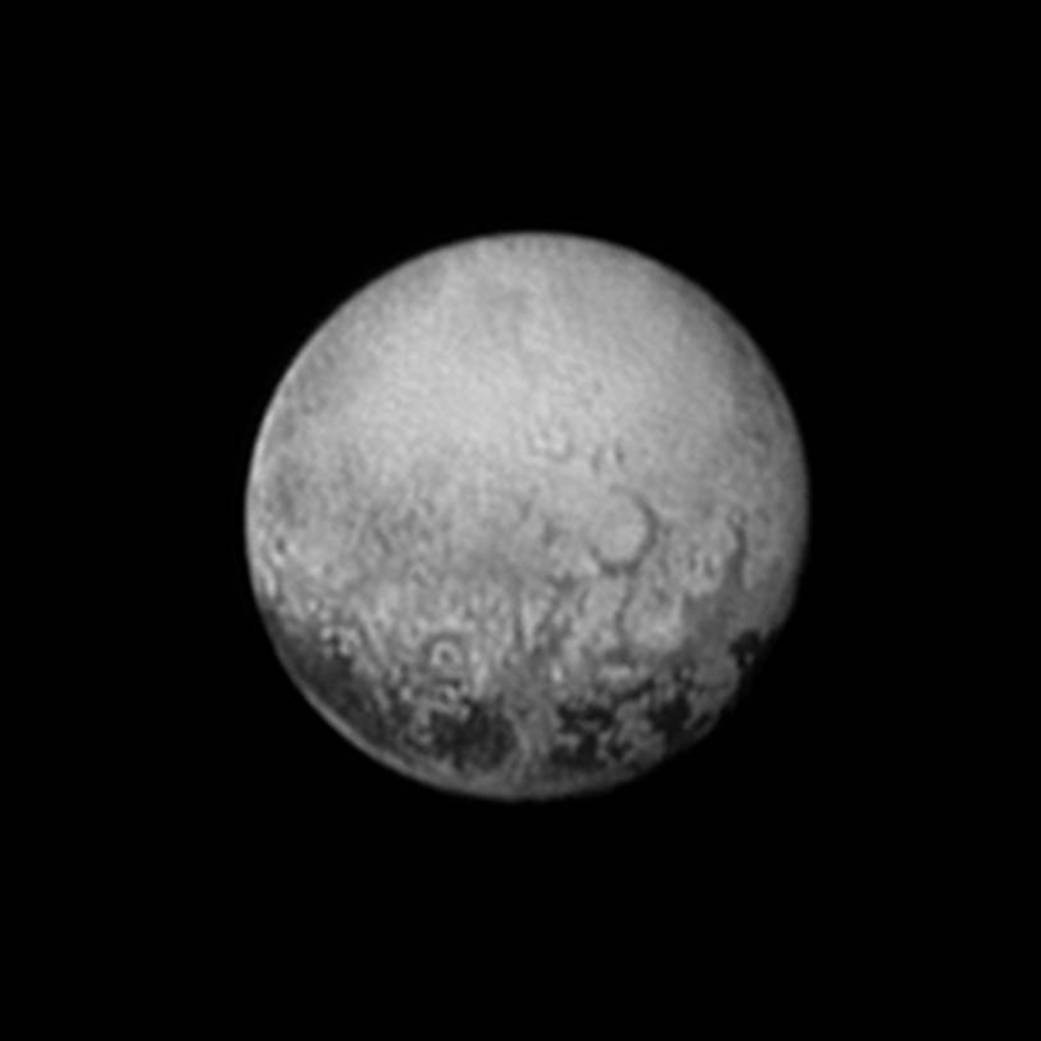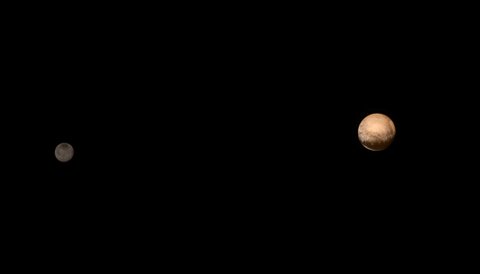With just one day remaining until New Horizons makes its historic flyby, missions scientists are amazed by the views of Pluto and Charon already in hand.
Normally the campus of Johns Hopkins University's Applied Physics Laboratory in Laurel, Maryland, is quiet, even pastoral. But nothing is normal about the events of this week.

NASA / JHU-APL / Southwest Research Institute
Tomorrow morning, at 11:49:58 Universal Time (about 7:50 a.m. Eastern Daylight Time), NASA's New Horizons spacecraft will zip past Pluto at 8.6 miles (13.8 km) per second. It's history in the making, and more than 200 news-media representatives have flocked to APL to be as close to the action as we can. So has virtually anyone who's ever had anything to do with Pluto — outer-planet researchers from across the U.S., the children of Clyde Tombaugh (Pluto's discoverer), James Christy (who found its largest moon, Charon), and a host of others.
In a way, it's The Last Picture Show in the 50-year-long exploration of our solar system by spacecraft. With all due respect to small-body missions like Dawn, Rosetta, and Hayabusa, Pluto represents a final milestone in our exploratory push outward from the Sun — "unfinished business," notes Alan Stern, the driving force behind New Horizons and its principal investigator.
(It's perhaps worth noting that, when this spacecraft left Earth in January 2006, the International Astronomical Union still considered Pluto the ninth and most distant major planet.)
And yet it's also The First Picture Show, our initial reconnaissance of a world in the frigid "third zone" of the solar system (the others being the realms of the four terrestrial and four giant planets). Stern points out that roughly 40% of all Americans weren't old enough to remember Voyager 2's encounter with Neptune in 1989. So not only are we seeing, up close, our first denizen of the distant Kuiper Belt, but we're also experiencing the thrill of seeing a sizable world revealed for the first time in a quarter century.

NASA / JHU-APL / Southwest Research Institute
Observing from Earth and with the Hubble Space Telescope, planetary astronomers already knew basics like approximate diameters and overall surface reflectivity. They knew Pluto and Charon rotate in a gravitational coupling that keeps one hemisphere of each locked in the direction of its partner. Spectroscopy had revealed crude surface compositions (Pluto has frosts of methane and nitrogen, whereas Charon is covered in water ice), and an occultation by Pluto in 1988 showed that it has a thin atmosphere.
One basic characteristic of Pluto that has eluded astronomers until now is its diameter. However, today Stern reported a new, more accurate value based on the spacecraft's imagery: 2,370 km (1,475 miles) with an uncertainty of ± 20 km. Based on previous occultation work, researchers assumed it was at least 2,302 km but really didn't know the real value very well. That simple refinement has three immediate consequences:
- Pluto is slightly larger than Eris (2,336 ± 12 km); the two had been in competition for King of the Kuiper Belt since the latter's discovery a decade ago. Interestingly, despite being very slightly smaller, Eris has a mass 27% greater than Pluto's.
- Overall, Pluto's density must be lower than thought, somewhere around 1.90 g/cm³ instead of 2.05 g/cm³. The thinking had been that Pluto must be about 70% rock and 30% (mostly water) ice, but the ice fraction is apparently somewhat higher.
- The larger radius means that the "dense" lower portion of Pluto's ultra-thin atmosphere, the part that can't be probed during stellar occultations, must be shallower than thought.
Based on the images and other data received from New Horizons in the past few days, Pluto and its cohort of five moons are not going to disappoint us. Instead, missions scientists are already talking about how so many of the results to date have been unexpected.
Two Very Different Worlds
Most obvious are the night-and-day differences between Pluto and Charon. The spacecraft has been sending a steady trickle of images and other measurements back to its handlers on Earth, and those confirm most of what we thought we knew. But now we clearly see that much of Pluto's equator is girded by an interconnected patchwork of dark features. The polar regions appear to be capped with icy frosts. At today's briefing, Stern announced that the craft's infrared spectrometer had confirmed the polar presence of nitrogen and methane ices.
Conversely, Charon is dark at its northern pole, and its surface is rather uniformly colored. Craters, fractures, and other physical features are emerging from the ever-improving resolution. One particularly obvious gash crosses the southern hemisphere and appears to be longer and and much deeper than Earth's Grand Canyon.

NASA / JHU-APL / Southwest Research Institute
Meanwhile, the instrument called PEPSSI (short for Pluto Energetic Particle Spectrometer Science Investigation) detected nitrogen ions — escapees from Pluto's atmosphere — five days ago and roughly 4 million miles (6 million km) on its sunward side. Apparently neutral molecules are flying away in all directions (Pluto's escape velocity is only 1.2 km per second), then become ionized either by ultraviolet sunlight or by interacting with the solar wind.
One of the mission's major scientific objectives is to determine how rapidly Pluto is losing gas to interplanetary space. But encountering nitrogen so far away defies the pre-encounter models. Maybe there's more gas in the atmosphere than believed, or the conversion to ions is unusually efficient, or some mechanism is concentrating nitrogen along the spacecraft's flight path.
While the best is yet to come, don't expect a deluge of awesome imagery right after the flyby. In fact, New Horizons will be so totally preoccupied with its preplanned observations of Pluto & Co. tomorrow that it will remain incommunicado for more than 12 hours after its closest approach. The mission team won't even know whether the spacecraft survived its encounter — let alone successfully stashed the scientific goods in its onboard memory — until 8:53 p.m. EDT tomorrow night.
That bit of news will be the most anticipated of the entire 9½-year-long mission.
 6
6









Comments
Robert-Casey
July 13, 2015 at 5:00 pm
Looking at the image released July 13th (the one with the heart rotating into view), it looks like Pluto has activity that wipes out craters. That the surface isn't ancient. Charon looks like it has craters, though.
You must be logged in to post a comment.
Ted-Hauter
July 13, 2015 at 9:15 pm
We all know here that there is nothing odd about this pairing of Pluto and Charon.
Pluto is the ninth planet. Charon is Pluto's moon.
Nothing odd about that.
But Pluto's demotion in 2006 being declared by a body of non-planetary scientists is very odd.
Very odd indeed.
You must be logged in to post a comment.
July 14, 2015 at 8:17 am
Dear Ted,
I could not agree more with you. Pluto -even conventionally- should have remained the 9th planet. At least, in our minds and hearts, it still is.
Waiting for its first close-up pictures of the smallest member of our solar family,
Christos
You must be logged in to post a comment.
A-T
July 14, 2015 at 9:56 pm
I completely disagree. I think that would fly in the face of the very spirit of science. If that sounds dramatic, consider the fact that the scientific worldview openly and proudly accepts that it's incomplete and occasionally wrong, something that no other worldview does. What else sets it apart is that it works, and by and large, the only thing that matters is that it works and what else works to explain why it works. It's a constant state of flux, of experimentation, categorization, a never-ending process of refinement that strives to build, piece by piece, an explanation for this world. There is no room in this goal for sentimentality. If we have a category of body that suits Pluto better, which we didn't have before, then that is the only thing that should matter. What the general public thinks of Pluto is irrelevant.
You must be logged in to post a comment.
A-T
July 14, 2015 at 10:01 pm
Imagine if, when scientists realized that the Iguanodon's spike was not its nose but its claw, they ignored that development because "people liked it where it was". That is the absurdity of what you're proposing.
You must be logged in to post a comment.
Anthony Barreiro
July 14, 2015 at 3:13 pm
I don't understand why people are unhappy that Pluto is now considered a dwarf planet.
From antiquity, Mercury, Venus, Mars, Jupiter, and Saturn were considered "astrae planetae", literally "wandering stars". When people started looking at them through telescopes, they figured out that the planets are spheroid bodies orbiting the Sun and reflecting sunlight, unlike the "fixed" stars which shine with their own light. The discoveries of Uranus and Neptune added to the picture, but didn't require a new classification system.
When Ceres was discovered in 1801, everyone was excited that the "missing planet" predicted by Bode's Law (or Bode's rough coincidence) between Mars and Jupiter had finally been discovered. As more and more "asteroids" were discovered in orbits similar to Ceres', people figured out that Ceres was the largest and first-discovered member of a new class of "minor planets." So far as I know, nobody complained that Ceres had been "demoted."
In 1930 Clyde Tombaugh discovered a new planet in an odd orbit, much more eccentric than any of the other planets, steeply inclined to the plane in which all the other planets orbit the Sun, mostly but not entirely beyond the orbit of Neptune. Young Venetia Burney suggested naming this new planet after the Roman god of the underworld, and then Walt Disney drew a cute dog also named Pluto.
Starting with 1992 QB1, in the past 23 years over 10,000 objects with orbits similar to Pluto's have been discovered. Most of these objects are much smaller than Pluto, but several are in the same size range. We figured out that Pluto is the largest and first discovered member of the Kuiper Belt. In 2006 the International Astronomical Unit formalized the definition of "planet" and created a new category of "dwarf planet" for Ceres, Pluto, Eris, Haumea, and Makemake.
Whether you consider Pluto and the other large Kuiper Belt Objects planets, dwarf planets, minor planets, or some idiosyncratic nomenclature of your own imagining, the fact remains that our classification systems have had to expand and elaborate in response to our growing understanding of the size and complexity of our solar system.
You must be logged in to post a comment.
You must be logged in to post a comment.